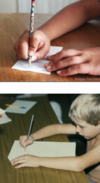M1-L11: Ax Fine Motor Flashcards
(65 cards)
_____ and ______ represent some of the highest levels of performance
Hand skills; expressive speech
What are 10 hand functions?
- grasp, hold, release
- manipulation of objects
- feeding
- shielding the body
- protection during falls
- support, balance
- communication: writing, gesture
- interpretation of sensation
- social responses
- music and art
What are the 5 dveelopments of hand function?
- Neural growth
- Sensory development
- Neuromuscular control
- Muscle strength & joint range
- Experience & practice
What is neural growth as a development of hand function?
Maturation and integrity
What are 5 sensory development of hand function?
- touch: leads the hand to grasp & the eye to look
- vision: eye-hand control
- position awareness: important for manipulation
- movement: important for development of function
- feedback for co-ordination
What is neuromuscular control as a development of hand function?
stability muscles must provide a postural background for
mobility muscles
What is the ICF participation for education?

What is the ICF participation for play?

What is the ICF participation for outdoor play?

What is the ICF participation for ADL?

What are 4 important features in the assessment setting?
- Quiet, tidy environment
- Seated at a table
- Table and chair height is size matched (ergonomic) for child
- Demonstrate using the child’s perspective (mirror image across the table may be difficult)
- Can sit across (interaction with toys) or next to child (same perceptive –> writing or tracing, using pen)
What is the order of development in the hand?

What is the age emerged, stimulus and response to the reflex grasp?
Age emerged = Newborns
Stimulus = Touch in the palm
Response = All fingers to palm

What does an atypical reflex grasp look like? When is it atypical? What is the complication?
- Persistent reflex, inability to open hand
- Could trigger continuously with own thumb in palm
- In older children
- Long term can cause contracture

What is the age emerged, stimulus, response and atypical response to the tactile grasp?
Age emerged = 10-12 weeks
Stimulus = Touch to the ulnar border
Response = Hand turns, follows then grasps
Atypical = absence of response

What is the age emerged, stimulus, response and atypical response to plucking/clutching?
Age emerged = 3 months
Stimulus = contact with clothing/fabric
Plucks = with lateral / ulnar 3 fingers
Clutches with palm and fingers
Atypical = absence, or persistent grasp

What is the age emerged, stimulus and response to m maintaining grasp on a toy?
Age emerged = 4 months
Stimulus = reaches for toy (eyes watch hand)
Response = grasps, and maintains grasp
Recognise toys coming towards them
Gross motor: prone on elbows (can reach forward to grab toy) or supine to reach antigravity

What is the age emerged for hands to feet?
6 months
- Abdominals working very hard
What is the age emerged for palmar approach?How does the child approach the palmar grasp?
- 6 months
- Child approaches toy with open hand

What is the age emerged and position for radial palamar (gross pincer)?
- 7 months
- Use base of thumb (radial) side of their hand and all fingers to grab objects into the palm

What is the age emerged and position for radial digital grasp?
8 m
- Holds with tips of thumb, index & middle fingers
- Sometimes called “Immature Tripod” or “Jaw Chuck Grasp”

What is the age emerged and position for the ranking grasp?
- 8 months
- Can see toys/food that are further away –> reach pass BOS –> rake grasp
- Need to be very careful as a parent as can start to pick up things on the floor

What is the age emerged and position for the take-from-transfer?
- 6-9 months
- Awareness of 2 sides of body
- Unable to release grip from hand

What is the age emerged and sequence (3) for the awareness of 2 sides?
6-9m
- Drops 1 object when offered another
- Holds 2 objects simultaneously
- Bangs 2 objects together

























